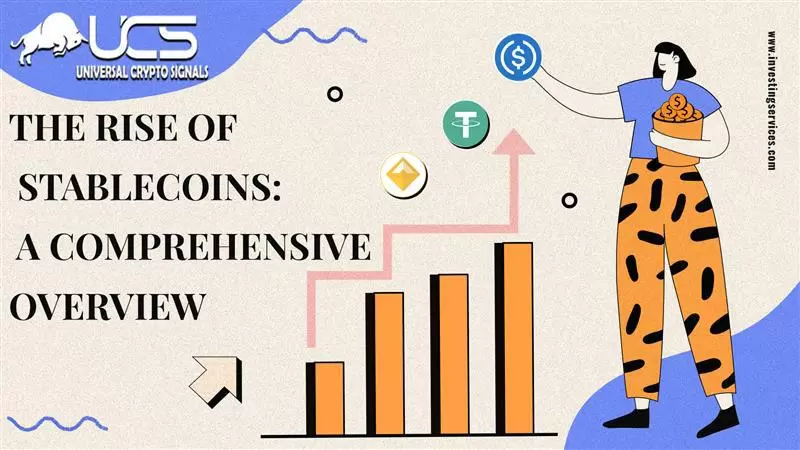- February 21, 2023
- Posted by: Subham Seth
- Category: News

The Rise of Stablecoins: A Comprehensive Overview
Stablecoin: Volatility has made cryptocurrencies less appealing for everyday use. To address this issue, a new type of cryptocurrency has emerged.
In this comprehensive overview, we will explore what stablecoins are, how they work, and their use cases, advantages, and potential future.
Major Insights-
- Stablecoins are a type of cryptocurrency that is designed to maintain a stable value relative to a specific asset or basket of assets.
- There are several types of stablecoin, including fiat-collateralized, cryptocurrency-collateralized, and algorithmic stablecoins.
- It has become increasingly popular in the cryptocurrency market due to their potential to reduce volatility and facilitate transactions.
What are Stablecoins and How Do They Work?
Stablecoin are a type of cryptocurrency designed to maintain a stable value relative to a specific asset or basket of assets, such as a fiat currency or a commodity. This stability is achieved by pegging the stablecoin’s value to the value of the underlying asset.
For example, a stablecoin pegged to the US dollar will always be worth one dollar, regardless of market fluctuations.
It work by using various mechanisms to ensure that their value remains stable. These mechanisms can include collateralization, algorithms, or a combination of both. Some stablecoins are backed by fiat currency, while others are backed by other cryptocurrencies or assets.
Types of Stablecoins
There are three main types of stablecoin: fiat-collateralized, cryptocurrency-collateralized, and algorithmic stablecoins.
-
Fiat-Collateralized Stablecoins
A fiat currency reserve, such as the US dollar or euro, backs a fiat-collateralized currency. The stablecoin issuer holds the fiat currency reserve, and the stablecoin’s value is pegged to the value of the reserve. The most popular fiat-collateralized stablecoin is Tether (USDT).
-
Cryptocurrency-Collateralized Stablecoins
Cryptocurrency-collateralized stablecoins are backed by a reserve of cryptocurrencies, such as Bitcoin or Ethereum. The stablecoin issuer holds the cryptocurrency reserve, and the stablecoin’s value is pegged to the value of the reserve.
The most popular cryptocurrency-collateralized stablecoin is DAI.
-
Algorithmic Stablecoins
Algorithmic are not backed by any asset. Instead, they use complex algorithms to maintain price stability. These adjust their supply and demand based on market conditions, ensuring that their value remains stable.
Examples of algorithmic stablecoins include Ampleforth (AMPL) and Frax (FRAX).
-
Use Cases for Stablecoins
Stablecoins have become increasingly popular in the cryptocurrency market due to their potential to reduce volatility and facilitate transactions.
-
Reduced Volatility
It offer a solution to the high volatility of traditional cryptocurrencies, making them more appealing for everyday use. This stability also makes a popular choice for hedging against market volatility.
-
Facilitated Transactions
It can be used to facilitate fast and efficient transactions, especially for cross-border transactions. Transactions can be completed quickly, with minimal fees, and without the need for a traditional financial institution.
-
Diversified Investment
Investors can use stablecoins to diversify their investment portfolios. Since stablecoins are pegged to the value of an underlying asset, they can provide a stable store of value and a low-risk investment option.
Read Also – North Korean Hackers Steal $620 Million In Crypto Robbery Targeting Axie Infinity Game
Advantages and Disadvantages of Stablecoins
There are several advantages and disadvantages to consider.
-
Stability:
provide price stability, which can be beneficial for merchants, investors, and individuals. This stability can help to reduce the risks associated with traditional cryptocurrencies, making stablecoins a more reliable choice for everyday use.
-
Decentralization:
Decentralized stablecoins are not controlled by any central authority. This decentralization provides users with greater control over their funds and reduces the risks associated with traditional financial institutions.
-
Accessibility:
Stablecoins are accessible as the demand for stablecoin continues to increase, and the need for global standards and regulations for these digital assets is becoming more apparent.
The Financial Stability Board (FSB) has recognized this need and has released a report on their proposed recommendations for stablecoin regulations.
In this article, we will discuss the FSB’s proposed regulations for stablecoin, the impact of these regulations on the industry, and the potential future of stablecoin.
The FSB’s Proposed Regulations for Stablecoins
The FSB, an international organization that coordinates the work of national financial authorities and international standard-setting bodies, has released a report detailing their proposed recommendations for stablecoin regulations.
These recommendations aim to address the potential risks posed by stablecoins, such as consumer protection, market integrity, financial stability, and monetary policy.
The FSB recommends that stablecoins be regulated in the same way as traditional financial instruments. This means that stablecoins would be subject to the same regulatory requirements as banks, such as anti-money laundering (AML) and counter-terrorism financing (CTF) regulations.
In addition, the Financial Stability Board requires stablecoin issuers to maintain adequate reserves to support the stablecoin and implement mechanisms to guarantee the stability of the stablecoin’s value.
The Impact of FSB Regulations on the Industry
The FSB’s proposed regulations could have a significant impact on the stablecoin industry.
Regulators’ adoption of these recommendations would necessitate compliance with banking-level regulatory requirements for stablecoin issuers, potentially leading to increased operating costs.
Stablecoin issuers may need to provide more transparency into their operations and the reserves backing their stablecoins.
The FSB’s proposed regulations could also help to increase consumer trust in stablecoins. By ensuring that stablecoin issuers are subject to the same regulatory requirements as banks, consumers may feel more comfortable using stablecoins as a means of payment or as a store of value.
Furthermore, adequate reserves and stability mechanisms implemented by stablecoin issuers may reduce the risk of stablecoin value fluctuations, thereby enhancing their reliability as a means of exchange.
The Future of Stablecoins
Have become an increasingly popular digital asset in recent years, with many users turning as a way to hedge against the volatility of other cryptocurrencies. As stablecoin usage continues to increase, the need for global standards and regulations becomes more apparent.
The FSB’s proposed regulations for stablecoin may be a step in the right direction, as they aim to address potential risks and increase consumer trust in stablecoins.
However, the future of stablecoin is still uncertain, and many questions remain unanswered.
Will stablecoin be able to compete with traditional currencies?
Will regulators be able to effectively enforce stablecoin regulations?
Undoubtedly, the increasing demand for stablecoins suggests that they may become an integral part of the financial landscape in the years to come
Conclusion
The FSB’s proposed regulations for stablecoin represent an important step in the development of global standards and regulations for digital assets. These proposed regulations aim to address potential risks and increase consumer trust. However, they may also increase operating costs for stablecoin issuers.
The future of stablecoins is unclear. Their growing popularity indicates that they could play a significant role in the financial system in the future.
As the stablecoin industry continues to evolve, it will be interesting to see how regulators and consumers respond to these digital assets.
Add a comment
You must be logged in to post a comment.



